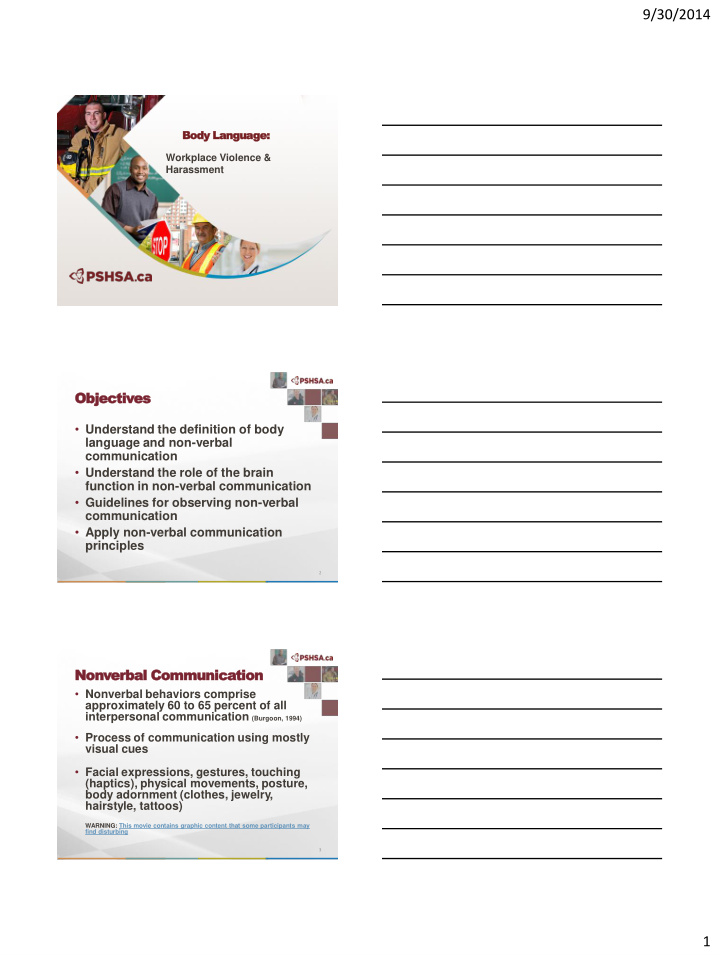



9/30/2014 Body Language: Workplace Violence & Harassment Objectives • Understand the definition of body language and non-verbal communication • Understand the role of the brain function in non-verbal communication • Guidelines for observing non-verbal communication • Apply non-verbal communication principles 2 Nonverbal Communication • Nonverbal behaviors comprise approximately 60 to 65 percent of all interpersonal communication (Burgoon, 1994) • Process of communication using mostly visual cues • Facial expressions, gestures, touching (haptics), physical movements, posture, body adornment (clothes, jewelry, hairstyle, tattoos) WARNING: This movie contains graphic content that some participants may find disturbing 3 1
9/30/2014 The Limbic System • Limbic system deals with basic drives, emotions, and memory • Hippocampus » Memory processing • Amygdala » Aggression and fear Pituitary Gland • Hypothalamus » Hunger, Amygdala thirst, body temperature, pleasure; pituitary gland, Hypothalamus anti-predatory defensive Hippocampus behavior 4 The Human Brain Limbic System reacts to the world around us reflexively and instantaneously in real time hardwired into our nervous system, making it difficult to disguise or eliminate Neocortex responsible for higher-order functions e.g. cognition and memory capable of complex thought therefore can deceive 5 Basic Limbic Response Freeze → Flight → Fight • Used to ensure the survival of our species • Freeze – first line of defense against a perceived danger, reduce movement, allows helps brain assess situation • Flight - escape the threat or distance oneself • Fight - final tactic for survival through aggression 6 2
9/30/2014 Guideline Guidelines s for or Obser Observing ving Nonverbal Communication 1. Competent observer of your environment 2. Observe in context 3. Decode universal nonverbal behaviors 4. Decode idiosyncratic nonverbal behaviors 5. Establish baseline behaviors 7 Guideline Guidelines s for or Obser Observing ving Nonverbal Communication (Cont’d) 6. Multiple behaviors occurring in clusters 7. Changes in a person’s behavior as signals 8. Learning to detect false nonverbal signals 9. Distinguish comfort / discomfort 10. When observing others, be subtle 8 Keep in Mind When Reading Nonverbal 1. Get a clear view 2. Expect pacifying or soothing behaviors 3. Expect initial nervousness 4. Get person to relax first 5. Look for increased use of pacifying behaviors 9 3
9/30/2014 Keep in Mind When Reading Nonverbal (cont’d) 6. Ask, pause, observe 7. Keep interviewee focused 8. Chatter is not the truth 9. Isolate the cause of the stress 10. Pacifying says so much 10 Posi sitive FACE Large pupils High eyebrows ARMS FEET AND LEGS Gravity defying Rocking up and down movements Walking with a bounce Arm gestures Toes upward Ankles crossed TORSO Ventral display Ventral action Mirroring Shoulder full shrug 11 Negative FACE ARMS Small pupils Arm withdrawal Low eyebrows Lack of arm movement Eye blocking Blocking Lip purse Spread Sneer Akimbo Furrowed forehead Nose Flair FEET AND LEGS Blushing Foot kicking Jiggling start / stop TORSO Toes inward / Ventral denial interlocking feet Torso shield / splays Lack of movement Chest puff / bare Rubbing hands on legs torso Move front to back of Deep Breathing chair Shoulder half / slow 12 4
9/30/2014 Nonverbals of the Feet and Legs • Territorial displays – try to re- establish control of situation and territory • Leg Splay – create balance and claim territory • Starters position • Walking style • Never crossed • Direction of the feet 13 Nonverbals of the Torso, Hips, Chest, and Shoulders • Houses vital organs, brain will protect it when threatened • Ventral denial • Torso shield • Torso splay • Puffing up the chest 14 Nonverbals of the Arm rms • Dominate individuals Spread materials Use elbows Arm around chair Arm movement • Arms Akimbo • Hooding • Arm freeze 15 5
9/30/2014 Nonverbals in the Hands and Fingers • Hidden hands • Offending gestures • Avoid preening • Frozen hands • Thumb display • Grabbing • Steepling • Hand wringing • Quivering 16 Nonverbals of the Face • Pupil dilation and constriction • Eye blocking – squinting • Eye-gaze • Blink rate 17 Nonverbals of the Face (CONT’D) • Lip compression • Sneer • Furrowed forehead • Nose Flair • Blushing / Blanching 18 6
9/30/2014 ACTIONS CAN SOMETIMES SPEAK LOUDER THAN WORDS 19 Violence Exercise • Identify the body language that reflects mood • Identify the stages of freeze, flight & fight through body language • Record your findings on the worksheet 20 Violence Behaviour Exhibited Furrow Brow Heavy Breathing Eye narrow? Chest puff Excessive arm Red face movement Ventral denial Flared nostril Physical grab Lip disappearance Aggressive walk Raised upper lip 21 7
9/30/2014 Harassment Exercise • Identify the body language that reflects mood • Identify the stages of freeze, flight and fight through body language • Record your findings on the worksheet 22 Harassment Behaviour Exhibited Exhibited Excessive blinking Withdraw Eyes widen Deep Loss of eye breathing contact Ventral denial Pacifier Blanched face Nose crinkle 23 Questions Sandra Excellent HBSc BASc MSc Regional Consultant Public Services Health & Safety Association sandraexcellent@pshsa.ca Reference Navarro, J. (2008). What Every BODY is Saying . New York; Harper Collins 24 8
Recommend
More recommend